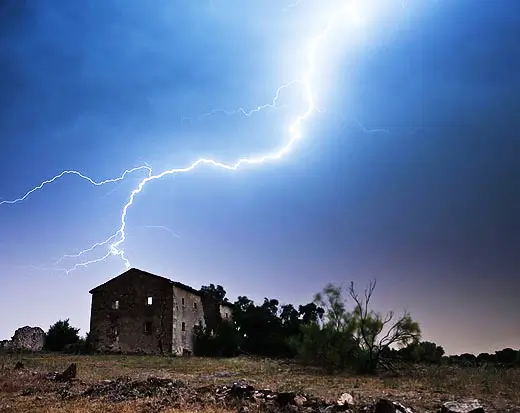Do Metal Roofs Attract Lightning? Debunking the Myths
When it comes to choosing a roofing material, metal is often praised for its durability, energy efficiency, and sleek appearance.
But if you’re considering a metal roof for your home, you might have heard a common concern: Do metal roofs attract lightning? This question sparks a lot of debates and, understandably, causes hesitation among homeowners.
No, metal roofs do not attract lightning. Lightning strikes are determined by factors like height, shape, and isolation, not the roof’s material.Metal roofs can be safer during a storm because they are non-combustible and can disperse the energy from a lightning strike more effectively.
In this article, we’ll delve into the facts behind this claim, debunking myths and providing clear, science-backed answers. Whether you’re worried about safety or simply curious, understanding how metal roofs interact with lightning is crucial for making an informed decision.
Let’s explore how metal roofs relate to lightning, so you know what to expect.
What Causes Lightning to Strike Metal Roofs?

First, let’s clear up a common misconception: Metal roofs do not attract lightning. Lightning is attracted to the highest point in an area, regardless of the material. I
t’s all about height and isolation, not the type of roofing material. Whether your roof is made of metal, asphalt shingles, or clay tiles, the likelihood of it being struck by lightning is the same. The key factor is location—if your home is the tallest structure in a flat area, it’s more likely to be struck.
Lightning strikes occur because of a buildup of electrical charges in the atmosphere. When these charges reach a critical point, a lightning bolt forms, seeking the path of least resistance to the ground. Often, this path is a tall object like a tree, tower, or, occasionally, a building. The material of the building’s roof is not what attracts the lightning; it’s the structure’s height and prominence.
According to the National Weather Service, the U.S. experiences about 25 million lightning strikes each year, but the chance of a single home being struck is about 1 in 200.
Roofing Materials with Fire Ratings
One of the most significant advantages of metal roofs is their excellent fire resistance. Roofing materials are often rated by their ability to resist fire, with ratings categorized as Class A, B, or C.
- Class A: The highest rating, indicating the material can withstand severe exposure to fire, making it the best choice for fire-prone areas.
- Class B: Provides moderate fire resistance.
- Class C: Offers the lowest level of fire resistance.
Metal roofs typically receive a Class A fire rating because they are non-combustible. Unlike wood or asphalt shingles, metal does not ignite easily, making it a safer choice during a lightning storm. Even if lightning were to strike a metal roof, the risk of fire is minimal compared to other materials.
Do Metal Roofs Resist Fire?
Absolutely! Metal roofs are among the most fire-resistant roofing materials available. As mentioned earlier, most metal roofing materials are rated Class A for fire resistance. This high rating means they can withstand severe exposure to fire without igniting. This resistance is particularly crucial in areas prone to wildfires or intense storms where lightning strikes are more frequent.
Moreover, metal roofs are not just resistant to external fires. They can also prevent the spread of internal fires, offering an added layer of protection for your home. While other roofing materials like wood or asphalt can catch fire and spread flames quickly, metal roofs act as a barrier, keeping the fire contained and reducing overall damage.
How Can You Protect Your Roof from Lightning?
While metal roofs are safe during thunderstorms, it’s understandable to want to take extra precautions. Here are some practical steps to further protect your roof and home from lightning:
- Install a Lightning Protection System (LPS): A properly installed LPS can direct the lightning strike safely into the ground, preventing damage to your home. This system includes air terminals (lightning rods), bonding conductors, and ground electrodes that work together to control the electrical energy.
- Grounding: Ensure your metal roof is properly grounded. Grounding allows the electricity from a lightning strike to flow directly into the earth, reducing the risk of damage.
- Trim Trees Near Your Home: Tall trees near your house can attract lightning, which can then jump to your roof. Keeping trees trimmed and healthy reduces this risk.
- Regular Maintenance: Keep your roof in good condition by regularly inspecting it for any signs of wear and tear. Damaged roofing materials can create vulnerabilities, increasing the risk of fire or structural damage if struck by lightning.
Pro Tip: If you live in an area with frequent lightning storms, consider investing in surge protectors for your home’s electrical system. This simple addition can prevent costly damage from power surges caused by lightning strikes.
How Metal Roofs Protect Your Home
Besides being safe during lightning storms, metal roofs offer a variety of benefits that protect your home in the long run:
- Durability: Metal roofs can last 40-70 years, far longer than traditional asphalt shingles. They can withstand harsh weather conditions, including high winds, heavy snow, and hail.
- Energy Efficiency: Metal roofs reflect solar radiant heat, which can reduce cooling costs by 10-25% during the hot summer months. This energy efficiency makes them a smart choice for eco-conscious homeowners.
- Environmentally Friendly: Most metal roofing materials are made from recycled content and are 100% recyclable at the end of their life. This sustainability is a significant advantage over traditional roofing materials that end up in landfills.
- Low Maintenance: Unlike other roofing materials that may require frequent repairs or replacements, metal roofs require minimal maintenance. Their durability means fewer headaches and lower long-term costs for homeowners.
What Is the Best Roofing Material for Lightning?
When it comes to lightning safety, metal roofs are one of the best options available. Not only do they not attract lightning, but they also offer superior fire resistance and structural integrity during storms. However, if you’re considering other materials, here’s a quick comparison:
- Asphalt Shingles: While affordable and popular, asphalt shingles offer minimal fire resistance and may not fare well during severe storms.
- Clay or Concrete Tiles: These materials are also fire-resistant and durable but are much heavier than metal, requiring additional structural support.
- Wood Shingles or Shakes: Though aesthetically pleasing, wood is highly flammable and not recommended for areas prone to lightning strikes or wildfires.
Metal roofs provide an excellent combination of safety, durability, and energy efficiency, making them an ideal choice for homes in lightning-prone regions.
Conclusion
So, do metal roofs attract lightning? The answer is a resounding no. Metal roofs are not only safe but are also a smart choice for homeowners looking to protect their property from the elements. Their fire resistance, durability, and energy efficiency make them an all-around excellent option. By taking a few additional precautions, like installing a lightning protection system and grounding your roof, you can further enhance your home’s safety during storms.
If you’re considering a new roof or a replacement, metal should be at the top of your list. Not only will you enjoy peace of mind during a thunderstorm, but you’ll also benefit from lower energy bills, reduced maintenance, and a roof that can stand the test of time.

